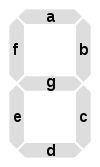Tool for translating abcdefg codes (or binary or numeric codes) into 7-segment display (the name given to digital screens dedicated to numbers on alarm clocks, watches, etc.)
7-Segment Display - dCode
Tag(s) : Electronics, Symbol Substitution, Character Encoding
dCode is free and its tools are a valuable help in games, maths, geocaching, puzzles and problems to solve every day!
A suggestion ? a feedback ? a bug ? an idea ? Write to dCode!
7-Segment Display
7-Segment Decoder
7-Segment Encoder
Answers to Questions (FAQ)
What is a 7-segment display? (Definition)
A seven-segment display is a popular digit display device, using 7 dashes that can be turned on or off, usually arranged in the form of the numeral 8. Turning individual segments on or off will display different numbers, letters, and symbols.
How does a 7 segment display work?
The display consists of seven segments identified by a letter (from a to g), organized as follows:  and each segment is generally associated with an LCD screen or a LED and can thus be activated / on 1 or off 0. There are a total of 128 possible combinations of display, although it is most often the combinations for the 10 digits (from 0 to 9) that are used.
and each segment is generally associated with an LCD screen or a LED and can thus be activated / on 1 or off 0. There are a total of 128 possible combinations of display, although it is most often the combinations for the 10 digits (from 0 to 9) that are used.
| bc | .png) |
|---|---|
| abdeg | .png) |
| abcdg | .png) |
| bcfg | .png) |
| acdfg | .png) |
| acdefg | .png) |
| abc | .png) |
| abcdefg | .png) |
| abcdfg | .png) |
| abcdef | .png) |
How to encrypt with a 7 segment based cipher?
Segment combinations can represent characters. A combination is generally identified by a series of 1 to 7 letters (from a to g) corresponding to the activated segments.
It is also possible to identify them with a binary string 1 = active, 0 = inactive, starting from the end gfedcba. In this way a is 0000001 and g is 1000000
The 7-segments displays may be common cathode (CC) or common anode (CA), in this second case the 0 and 1 are switched.
How to decrypt a 7 segment cipher?
What is a common anode or common cathode display?
In a common cathode display, these are connected to the low potential, a segment is displayed by activating it in its logical 1 position.
In a common anode display, these are connected to the high potential, so a segment is displayed by activating it in its logical 0 position.
How to recognize a 7 segment ciphertext?
The code consists of the letters a,b,c,d,e,f,g only, in groups of 1 to 7 letters without repetition.
For the binary variant, the codes are normally on 7 bits from 0000000 to 1111111.
The presence of a calculator, a clock or a digital watch or the characters 7SEG are clues.
What are the variants of the 7 segment display?
There exist also 9 segment displays (with an additional 2 segment diagonal), 14 segments (with 2 diagonals and a central vertical bar) or 16 segments (identical to the 14 segments but with the top and bottom segments cut in half).
The Beghilos code uses the 7 segments with a reverse reading (backwards).
When were 7-segment displays invented?
The first patents date from the beginning of the 20th century (1903, 1908, 1910) but the advent of the displays came in the 1970s.
Source code
dCode retains ownership of the "7-Segment Display" source code. Any algorithm for the "7-Segment Display" algorithm, applet or snippet or script (converter, solver, encryption / decryption, encoding / decoding, ciphering / deciphering, breaker, translator), or any "7-Segment Display" functions (calculate, convert, solve, decrypt / encrypt, decipher / cipher, decode / encode, translate) written in any informatic language (Python, Java, PHP, C#, Javascript, Matlab, etc.) or any database download or API access for "7-Segment Display" or any other element are not public (except explicit open source licence). Same with the download for offline use on PC, mobile, tablet, iPhone or Android app.
Reminder: dCode is an educational and teaching resource, accessible online for free and for everyone.
Cite dCode
The content of the page "7-Segment Display" and its results may be freely copied and reused, including for commercial purposes, provided that dCode.fr is cited as the source (Creative Commons CC-BY free distribution license).
Exporting the results is free and can be done simply by clicking on the export icons ⤓ (.csv or .txt format) or ⧉ (copy and paste).
To cite dCode.fr on another website, use the link:
In a scientific article or book, the recommended bibliographic citation is: 7-Segment Display on dCode.fr [online website], retrieved on 2025-12-24,
- 7-Segment Decoder
- 7-Segment Encoder
- What is a 7-segment display? (Definition)
- How does a 7 segment display work?
- How to encrypt with a 7 segment based cipher?
- How to decrypt a 7 segment cipher?
- What is a common anode or common cathode display?
- How to recognize a 7 segment ciphertext?
- What are the variants of the 7 segment display?
- When were 7-segment displays invented?

.png)
.png)